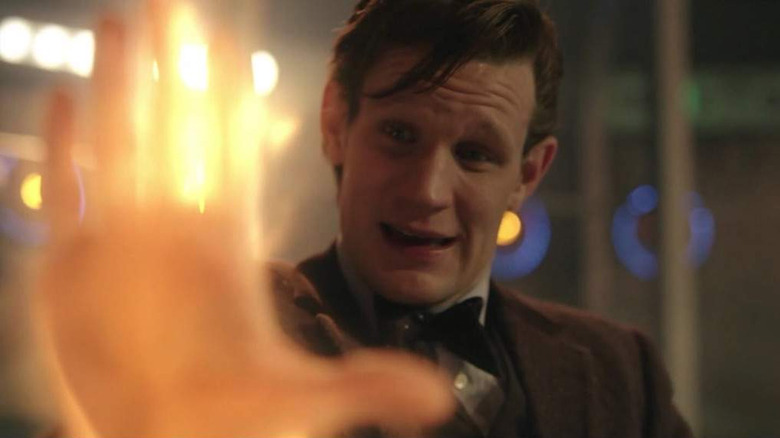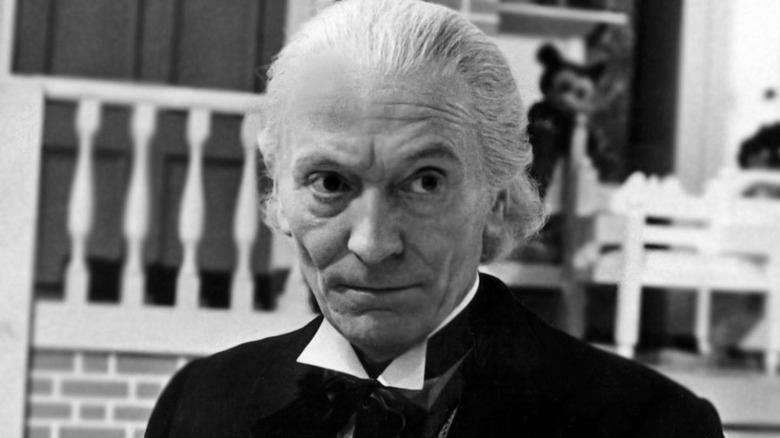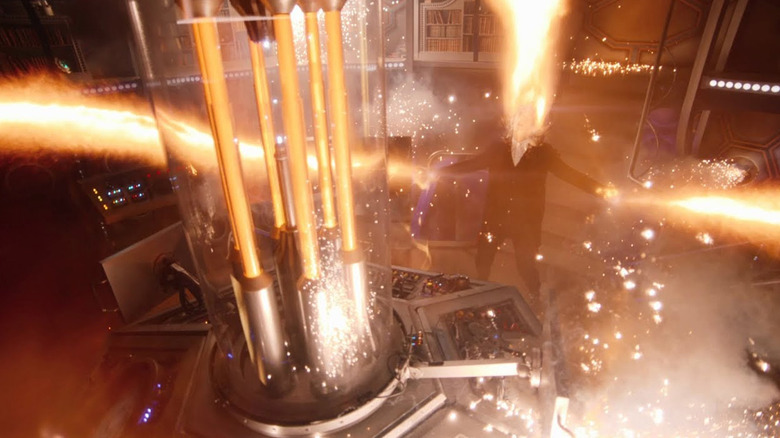Doctor Who's Regeneration Was A Sci-Fi Solution To A Real-World Problem
Classic British sci-fi show "Doctor Who" has been on our screens since 1963 and it's renowned for some of science fiction's coolest deus ex machina. The TARDIS, the sonic screwdriver, and the vortex manipulator are all answers to various futuristic storytelling problems.But the best one of all? Regeneration.
A signature ability of the Doctor, regeneration is the process of molecular readjustment that allows Time Lords to essentially cheat death ... at the expense of becoming a different person. Regeneration creates some of the show's most iconic moments — when a Doctor comes to the end of their tenure, passing the baton to their successor.
In the context of the show, it's a furious process — the Doctor literally bursting with regenerative energy as their bodies rewrite and reconfigure themselves into another form. The Thirteenth Doctor described it as "every cell in [her] body burning" as her "whole body changed."
"There's this moment when you're sure you're about to die and then ... you're born."
This rebirth allows the Doctor to become an entirely different person each time. And while early incarnations tended to be white men, we've recently seen the Doctor change skin color and even gender. Most recently, we saw Peter Capaldi's Twelfth Doctor regenerate into their current form, Jodie Whittaker. And with her time as the Doctor coming to a close, it won't be long before we see her regenerate into her successor, too.
But why does it happen?
The Time Lords explain that it's a biological process that kicks in like instinct, allowing them to survive certain death. But it's also a very neat solution to a real-world problem: what do you do when your lead leaves the show?
Doctor Who's first-ever regeneration
The First Doctor was famously played by William Hartnell, a role he kept until 1966. A combination of ill health and a clash with the show's creative team led to Hartnell's eventual departure ... but the BBC was keen to keep "Doctor Who" running.
"I'm not brassed off," said Hartnell in one of his few televised interviews.
But clearly, the grueling schedule was getting to him:
"It's the association of this Dalek question – this mechanical, mobile object that I'm beginning to find distracting. And they were difficult to play to because you're not looking into human eyes. You're looking at a metal object, moving about with a voice-over."
Of course, the BBC could have just recast the role. But they chose a more creative solution. Originally, producer John Wiles and script editor Donald Tosh planned to write out Hartnell during April 1966 story "The Celestial Toymaker." The classic "Doctor Who" villain would have made the Doctor disappear ... only to reappear later as an entirely different actor. Ultimately, this didn't pan out, but Hartnell's departure was still on the cards.
It's unclear who came up with the idea of regeneration, though it's thought to have been from discussions between new "Doctor Who" producer Innes Lloyd and his story editor, Gerry Davis. And so, in the October 1966 episode "The Tenth Planet," we saw the Doctor regenerate for the first time. This essentially allowed the BBC to recast the now-iconic role without any trickery — framing the recasting within the context of the sci-fi series itself. It's a neat trick and one that has served it well, with every new actor eventually regenerating into their successors before parting ways with the show.
As for Hartnell's successor, the man himself actually helped choose:
"There's only one man in England who can take over, and that's Patrick Troughton."
Troughton appeared for the first time as the Second Doctor in that very same episode and regeneration became a huge part of the Doctor's identity, and a part of the DNA of the show itself.
What happened when Hartnell regenerated?
The first-ever on-screen regeneration in "Doctor Who" was a fairly simple one. During the Cybermen's invasion of Earth, the Doctor becomes weak and is captured. Although he soon escapes and rescues his companions, it's clear that the Doctor is not himself. He's become frail since his earlier encounter with The Celestial Toymaker and explains to Polly (Anneke Wills) that his body is "wearing a bit thin."
After clambering back to the TARDIS, he collapses to the floor and begins the regeneration process — his face flooded with bright light as it transforms into that of a younger man. The episode ends with Patrick Troughton becoming the Doctor ... although little is explained about how this came to be.
Initially, the process of regeneration was simply termed "renewal" and it wasn't until the Doctor's third regeneration in 1974 that it was actually called "regeneration." But while the Doctor is revitalized with the vigor of a much younger man, it seems that his transformation came at a cost.
A BBC production note sheds some light on the regeneration process:
"The metaphysical change which takes place every 500 or so years is a horrifying experience — an experience in which he re-lives some of the most unendurable moments of his long life, including the galactic war. It is as if he has had the LSD drug and instead of experiencing the kicks, he has the hell and dank horror which can be its effect."
After the regeneration, it became clear that the process was not without side effects as the Second Doctor began experiencing post-regenerative issues. The most obvious? Confusion about his own identity — even though he adjusted to his new physical body with ease.
Essentially, regeneration had allowed the Doctor to avoid death at the hands of old age — a poignant moment considering Hartnell's own advancing years. More importantly, it allowed the BBC to recast its most iconic leading role with a solution that leaned into the show's science fiction background. It would become a long-running practice, too with the Doctor still regenerating to this day.
The Doctor had made his first-ever regeneration ... but there were many more still to come.
Regeneration became a Doctor Who staple
After Hartnell's successful transition into Troughton, "Doctor Who" embraced regeneration as its means of recasting the Doctor. Throughout the show's almost 60-year history, we've seen a total of 13 Doctors — each one of them regenerating from the last. Even if there were some mysterious transitions in-between.
But the process isn't exactly the same for every Doctor.
Since the Doctor's first regeneration, the process has been portrayed in many ways, with both physical and psychological effects on the Doctor's new incarnation. He's often depicted with some form of amnesia — a by-product of the regeneration process, which was introduced with the Seventh Doctor, Sylvester McCoy. But it can also cause other negative effects, including impaired motor functions and even an increased appetite as the Doctor becomes starved of energy. Thankfully, they tend to get over these side effects rather quickly ... but the regeneration process clearly takes its toll on the Doctor.
It's often explained that Time Lords experience a surge of regenerative energy during regeneration, causing their entire body to be rewritten across the very fabric of space-time. No wonder they're all pretty exhausted afterward.
Visually, the regeneration process differed from Doctor to Doctor until the show's revival in 2005. Here, showrunner Russell T. Davis created the new quintessential regeneration — the Doctor bathed in bright, golden light exploding from his face and hands. This form of regeneration has since been used by each subsequent Doctor.
Before this, regeneration varied from a bright white light that illuminated the Doctor's face during the transition, a cacophony of rainbow-colored lights, or even a crackle of electricity. However it looks, the iconic transformation has become a well-known part of the show.
Now, with Jodie Whittaker due to bow out from "Doctor Who" we're all waiting to see just who will take over as the Fourteenth Doctor. Not to mention, how her particular regeneration will pan out.


